Words and photos by Zoe van Buren
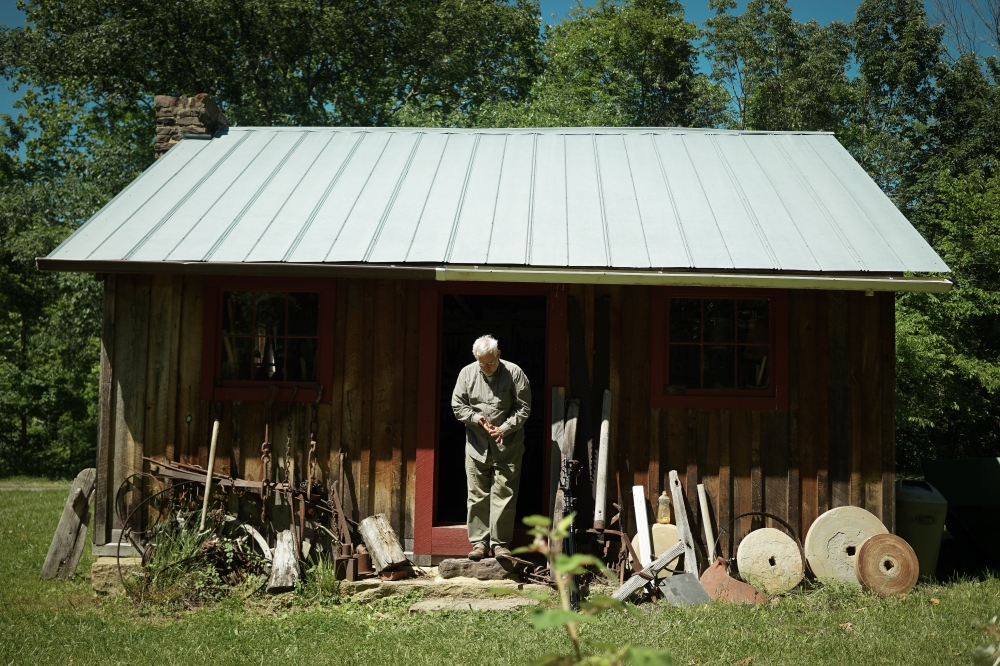
“I should have been a historical archaeologist,” said Jim Costa. “I guess I am in my own way.” Jim and I sat on the porch of his Summers County, West Virginia home, a restored 19th century log cabin built by a local Civil War veteran and saved from decay by Jim himself. It was the end of a humid and flooded summer, and we were doing one last interview before I prepared to go home. Jim and I spent two months together living as neighbors and documenting his collection of antique work tools with the West Virginia Humanities Council, after the new state folklorist Emily Hilliard introduced us that spring.
Jim is known to some as a skilled old-time fiddler and banjo player, but he has also spent his 67 years accumulating and restoring a hand tool collection of epic proportions, which he lives amongst on his tranquil oblong property tucked between the slope of a mountainside and the unruly banks of the Greenbrier River. Two workshops, a restored general store, and a barn-sized garage are bursting with objects of rural life and trade crafts, almost all from the 18th and 19th centuries and collected from the regions surrounding him. Inside his two-room cabin, dense with the smell of wood smoke, Jim’s relics become part of his everyday life. Hand-woven baskets hang from the rafters, fiddles and banjos line the log walls, and 19th century cast iron skillets live their ninth or tenth lives sizzling over his replica vintage stove.

As a graduate student in folklore at the University of North Carolina at Chapel Hill, I was intrigued by Jim’s collection as its own kind of folkloristic text—the product of years of scholarship, searching, and engaged listening to old folks and old documents, embedded deeply in his own day-to-day use. As a knitter and hand-spinner myself, raised in a family of handy types, I often think about the things we make ourselves, the tools we live by, and the objects that provoke imaginative reflection. Jim’s collection is all of these things and more—a lifetime’s accumulation of the relics of Appalachian work and everyday life, carefully restored to functionality and original aesthetic intent. If he could, he would like to have lived in the time these tools were made, but he lives amongst them nonetheless. “I just got very interested in the agrarian culture,” he said, “and everything they [farmers and homesteaders] did to live that kind of lifestyle– The various trades and crafts that they had to learn and apply for a self-sufficient lifestyle.” Jim collects historical objects dating from the first settlers in what is now West Virginia through the first industrially manufactured versions of a tool. “The factory versions of course start being produced and nobody makes anything by hand anymore. It puts you out of work. It’s another example of how people are put out of an occupation.”
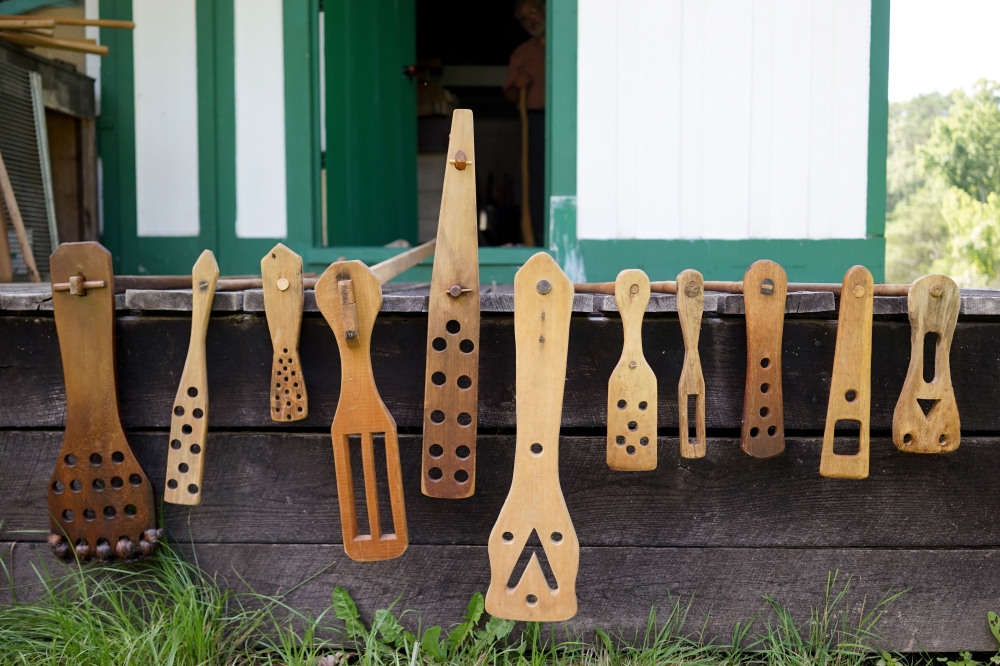
I arrived at Jim’s home with my own collection of documentary gear, but few certain plans. We had only met once before, and I knew I would need to follow his lead through his vast and intricate collection. “I’ll tell that, that’s a grand story to tell,” Jim said to himself, as he combed through the ironware, arranged by function, that hangs on the walls of his blacksmith’s shop, and we were off on another kind of work, another variation, another history.
Because I was able to spend the summer living on Jim’s property, our project unfolded on a spontaneous schedule as ideas for the next day’s documentation emerged from what had just been done—an unusual collaborative luxury I owe to Jim’s flexibility and endless hospitality. We often began the day with a porch-to-porch wave and a shout of “What are you up to today?” across the yard between our houses, before one of us would amble over with an arm full of recording equipment or a box full of hewing axes.
Between our days of documentary work, we made trips to auction sales, junk shops, and antique malls across southern West Virginia, scoping the neighboring counties for good finds and good friends. Jim would point out the oldest homeplaces along the road, often crumbling in disuse. He knows the story of each one, and the objects he has salvaged from them as their contents are sold or left to rot. As a lifetime resident of Summers County, Jim has learned not only from books and antique dealers, but from oral history and the recollections of old folks he grew up knowing. “I just think there was a great camaraderie, a great social camaraderie in that time,” Jim explained. “I’ve talked to these old people— when there was so much manual work that had to be done on these farms, boy you knew you neighbors very well. You knew all the positive and negative aspects of them. And there was a great camaraderie and sharing that came with that culture.” His collection may map the material culture of 18th and 19th century West Virginia, but those objects given to him by friends and neighbors chart the relationships he has had in his own life, and those that have come before.

Really, only half of Jim’s collection can be seen. The other half lives in his head, in the intimate knowledge he holds for each and every object that has ever passed through his hands, and his interest in the families that carried them down through the years. Jim and I quickly developed a documentary strategy that attempted to record these two halves of his collection together, arranging our photographs so that Jim could narrate them one by one or as a group, revealing the vast variety of style and aesthetics that emerges in even the most everyday thing when it is made by a person’s hands.

I had anticipated that Jim and I would work mostly in audio and still images, but as I passed time with Jim in his day-to-day life, my video camera became essential. Jim’s collection is not a static being, and his work with it is a daily practice, a creative and often meditative expression. I was interested in documenting not only how he stores and arranges his collection, but also how it is itself the product of Jim’s own skill and labor. Standing in the shade of his back porch, I watched and filmed as Jim fitted a new handle in an old axe head, repainted a mowing cradle to its original orange color, or varnished a wooden parlor table. At the cold, gusty mouth of the Great Bend Tunnel just a few miles from his home, I filmed Jim as he demonstrated the use of the manual railroad tools that built this iconic passageway, home to the John Henry legend that echoes Jim’s own collection in its tribute to the skill of the working man and the value of people over the machinery that replaces them.
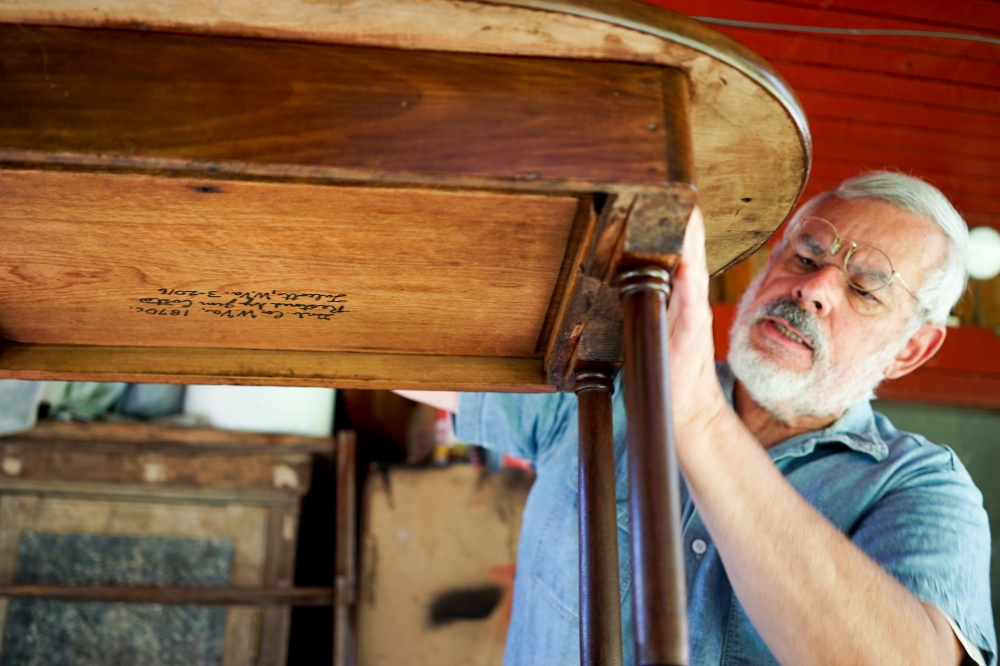
As Jim restores each object that he obtains, he himself becomes a part of its story. Much of his collection is marked with two dates: the date of manufacture, and the date he restored it, printed in black sharpie and signed with his initials “JVC”. Starting with clocks and guns in his teenage years, Jim has done restorations his whole life, for others and for his own collection. He has made much of his living from this work, along with historical demonstrations, fiddle playing, and his younger years spent working in his father’s electronics store. But the seeds of vocation were planted in his earliest years, as he explored the old tools and keepsakes in his grandparents’ homes around Hinton. Jim told me he can’t quite put a finger on how his interests became so powerful, but I found it’s hard not to take notice of the material vestiges of the past in a place as rich with old farmhouses, families, and flea markets as southern West Virginia. It’s hard not to think about hard work, good tools, and self-reliance. “Something has survived that long, and I was just compelled to see it survive longer, beyond my period of life,” Jim said as we sat on his porch, night falling quickly and the sound of cicadas threatening to drown out my audio recording. “Especially, that’s why I’m so much into restoration, fixing these things, stabilizing and restoring them… Whether they’re ever used or not, again, they have survived, they’ve been restored, and they’re functional.”
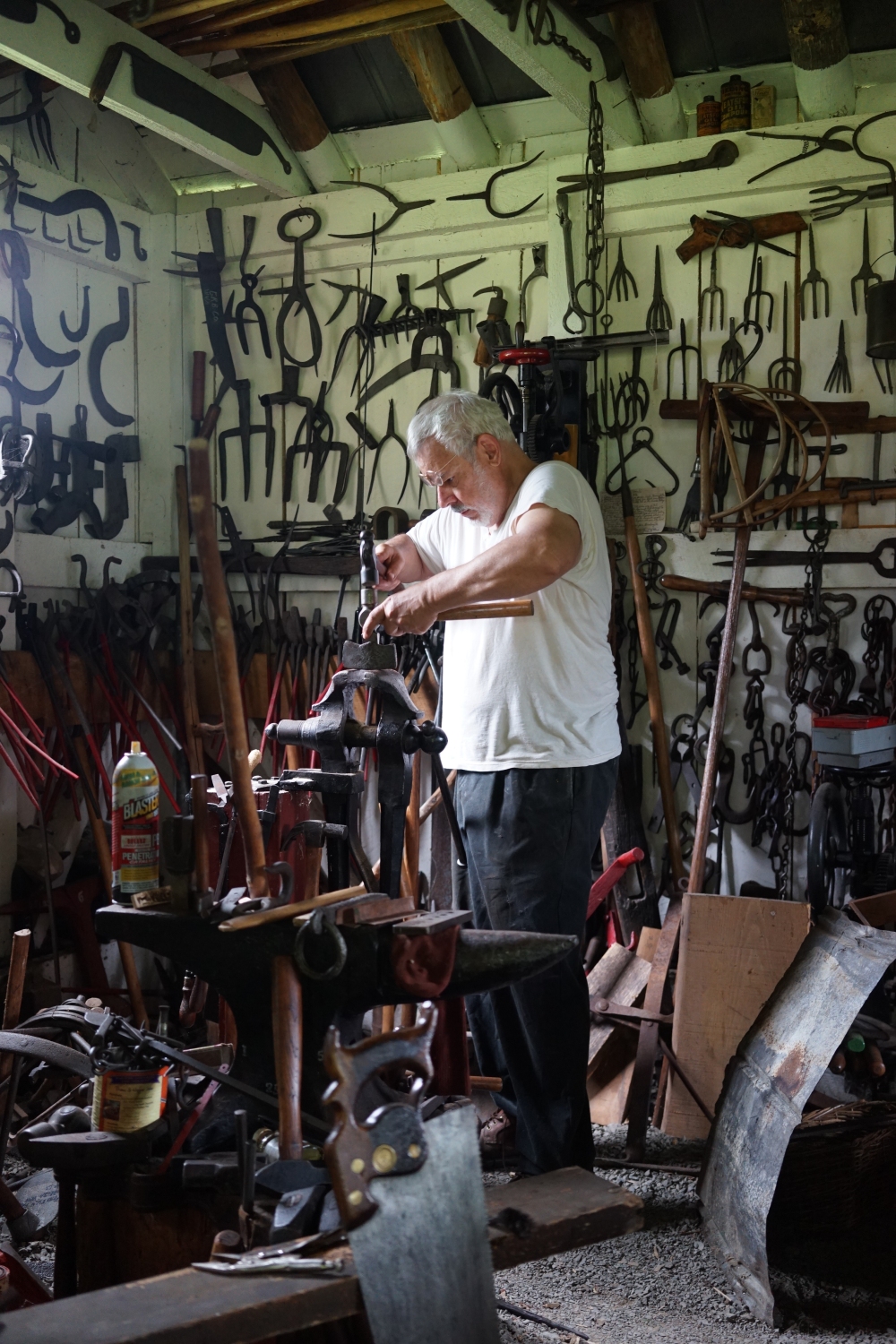
Jim has honed many of his restoration skills through trial and error, consultation with craftspeople, and the creative reuse of parts. His restorations echo the evidence of repair and reuse found on so many of the objects of rural life. A creative mend gives new meaning and aesthetic to a thing saved from the trash. So much is discarded today, when it is easier to make cheaply and replace often, but Jim’s collection shows life playing out in the skill of reuse. He may not use every tool himself, but Jim would like to pass them on to those who would. “I would hope to get them in the hands of somebody who will work them… I would like to see them used.”
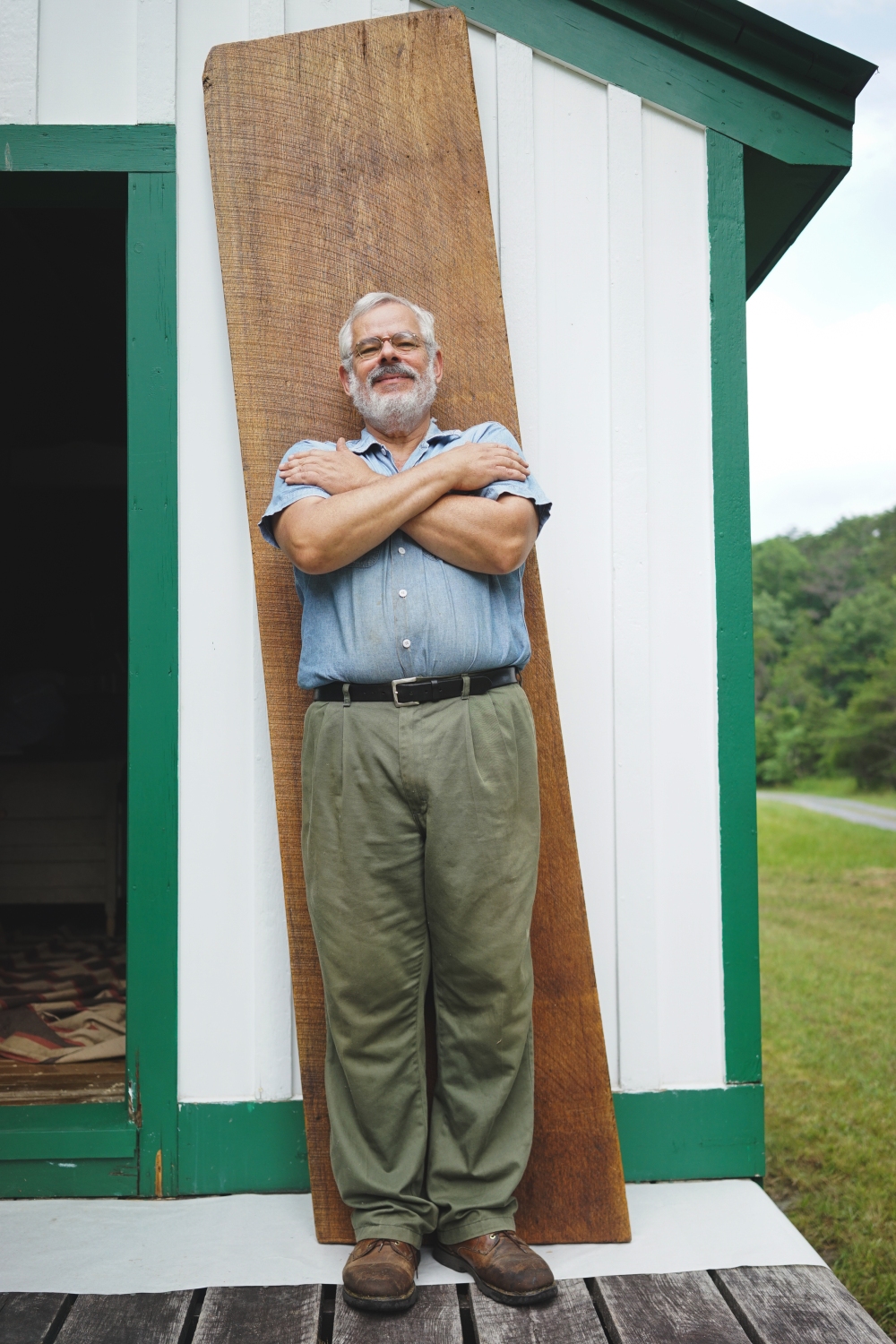
According to Jim, his collection is mostly complete at this point. It began with his earliest interest in old guns and clocks, and expanded into places he had never known he would find compelling. We photographed axe heads and loom heddles, sausage makers and spinning wheels, mining shovels and corpse cooling boards. He has found examples from every corner of life in the mountains, from the most common kitchen spoon to delicate “angel crowns,” feather clusters that form in the death-bed pillows of those who have gone to Heaven.

I am coming to understand the uniqueness of what Jim has done: there are niche aficionados for almost every type of antique on earth, but Jim’s mission is all-inclusive, propelled by his profound respect for the labor of self-sufficiency, the ultimate potential of good materials, and the skill of the human hand. In some respects his collection may be “complete”, but Jim also believes that when every handmade object is as unique as the person who made it, there is no such thing as redundancy. “I was always amazed at the variations of skill level in them,” he said. “I just really get caught up in that thing of the aesthetics… It gets redundant, but it’s not redundant if you look at it in the context that I do.” Jim often notes the quixotic nature of his crusade against decay and neglect, and he will self-depreciatingly refer to his work as his “madness.” But others know him as a West Virginia treasure, a one-of-a-kind steward of rural Appalachian cultural heritage, who has amassed a collection of both artifacts and knowledge that no museum could match.

“Who else cares?” Jim wondered, as he thought about what might become of his collection. “Who else would even care? I care too much I guess… I’m sentimental for all this old stuff that had some sort of worth and meaning to their lifestyle. It was essential. All those things of that material culture to me, they show a skill level of people. They show someone’s ability to do something. To physically be able to accomplish something, both mentally or physically, and how their hands created.”
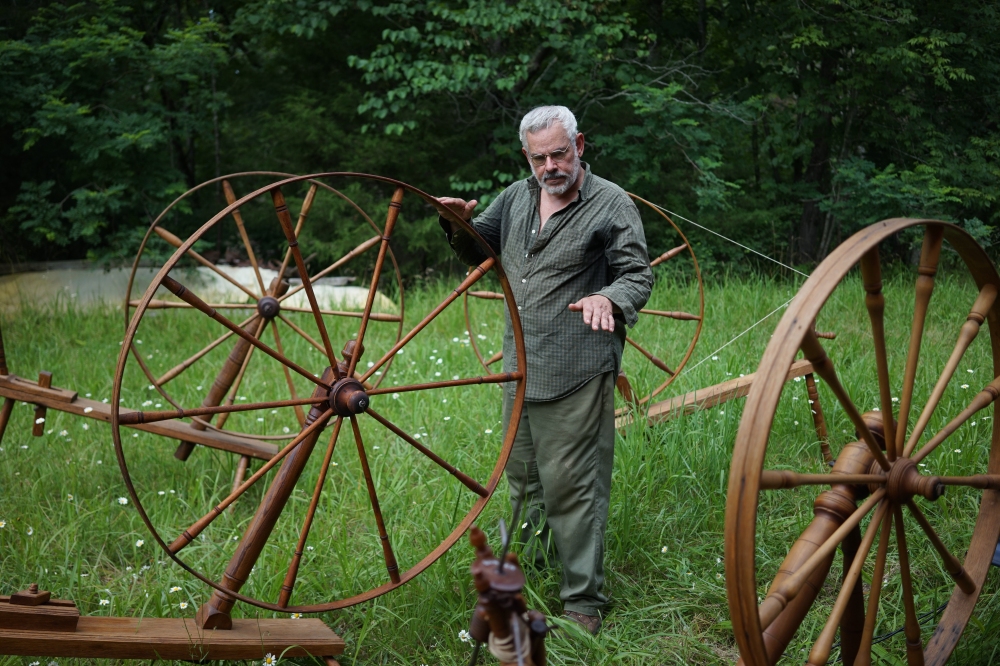
In the beginning, neither Jim nor I knew precisely what would emerge from our project. We hoped we would end with something useful, something searchable, and something reflective of what Jim has done over so many years. But for two months, we took hundreds of photographs, made hours of audio recordings and video footage, and we only just scratched the surface. I came as a folklorist and a documentarian, but spending time with Jim makes you think about the materials in your own life– the things you save, the things you throw away, the way even a simple object made from good material, with a purposeful hand, can make you feel. More than ever, I find myself thinking, “I can fix that. I could make that myself.”
I left Jim’s house when August arrived, a spinning wheel from his collection stowed in the trunk of my station wagon. It needs restoring, but I want, very badly, to put it to work again.


Loved the story. Loved what Mr. Costa is preserving even more. West Virginians are hard working, good people. His collection shows that.
LikeLike
Is it possible to visit Mr. Costa and his collection?
LikeLike
Hello Jeanette, Jim’s collection is private, but do keep an eye out for his public talks, including one at the Humanities Council in the near future.
LikeLike
Jeanette,
I used to work for the Greenbrier Historical Society and North House Museum (in Lewisburg, WV) and Jimmy frequently loans pieces from his collection to them. Try giving them a call to see what they currently have on display! http://www.greenbrierhistorical.org/
LikeLike
Good tip! Thanks, Camille.
LikeLiked by 1 person
Jimmy stopped by the Greenbrier Historical Society last Friday seeking information on another item. Conversation covered not only historical items but many other topics including The Humanities Council and the work that Zoe has done. This in turn inspired me to look further into the work Zoe did to document Jimmy’s collection. I just want to thank you for the work you do and I must say that Zoe hit a home run with her documentary.
LikeLike
Great article. I have known, and admired Jimmy Costa for 25 years or so. Your article captures the true essence of the Jimmy I know. He is a bona fide expert on the music of Uncle Dave Macon. I had much of the same relationship with the legendary Franklin George in Roane County where I lived. I live in Miami now. One of the last times I was with Jimmy and Franklin was at the Henry Reed Festival about 2009. We were also all together at the Franklin George Gather in Roane County about 2009. Thank you for you great article. Larry Dent
LikeLike